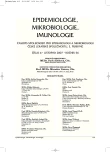Simultaneous Detection of Chlamydia pneumoniae and Chlamydia trachomatis DNA by Real-time PCR
Authors:
K. Roubalová
Authors‘ workplace:
NRL pro chlamydie, Centrum epidemiologie a mikrobiologie, Státní zdravotní ústav, Praha
Published in:
Epidemiol. Mikrobiol. Imunol. 56, 2007, č. 4, s. 166-173
Overview
Study objective:
Design and validation of a real-time PCR assay for quantitative detection of C. pneumoniae and C. trachomatis in clinical specimens.
Material and Methods:
A part of the 16S RNA gene was selected as the target sequence for amplification. The reaction product was cloned in the bacterial plasmid and a recombinant calibrator and a combined internal standard were prepared, usable in three different PCR assays. Archived DNA isolates from various clinical specimens, DNA isolates from other infectious agents and control samples for DNA detection, CT (QCMD) and CPN (Instand), were used for validation.
Results:
Reaction specificity and reproducibility were tested. The analytical sensitivity was set to 5–10 copies of the bacterial genome/reaction. As many as 105 DNA isolates from various types of clinical specimens (swabs, urine, peripheral blood and BAL fluid) were tested by real-time PCR and conventional PCR assays. The specimens that had not yielded concordant results were characterized by a third independent amplification test. The sensitivity and specificity of real-time PCR were 89 % and 100 %, respectively. The assay is suitable for both screening and diagnosis of Chlamydia.
Key words:
Chlamydia pneumoniae – Chlamydia trachomatis – diagnosis – real-time PCR.
Labels
Hygiene and epidemiology Medical virology Clinical microbiologyArticle was published in
Epidemiology, Microbiology, Immunology

2007 Issue 4
Most read in this issue
- Hrabák J.: Clinically Important Beta-Lactamases of Gram-Negative Bacteria: AmpC
- Babesiosis, a Little Known Zoonosis
- Simultaneous Detection of Chlamydia pneumoniae and Chlamydia trachomatis DNA by Real-time PCR
- Epidemiology of the Metabolic Syndrome and Possibility for its Prevention by Physical Activities
